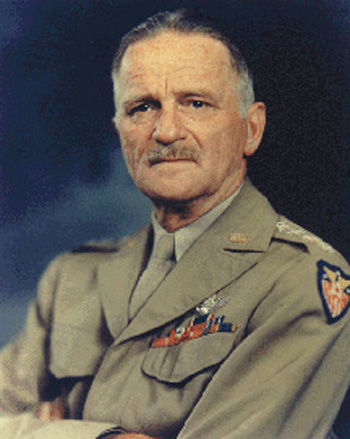
|
Carl A. Spaatz |
 |
|||
| Rank, Service | ||||
General O-10, U.S. Air Force |
||||
| Veteran of: | ||||
|
||||
| Tribute: | ||||
Carl Spaatz was born on June 28, 1891, in Boyertown, Pennsylvania. He entered the U.S. Military Academy on March 1 1910, and was commissioned a 2d Lt of Infantry on June 12, 1914. Lt Spaatz served with the 25th Infantry Division at Schofield Barracks, Hawaii, from October 1914 to October 1915, and then entered flight training at the Aviation School in San Diego, California, where he earned his pilot wings in May 1916. Capt Spaatz next served with the 1st Aero Squadron under Gen John J. Pershing in the Mexican Punitive Expedition from June 1916 to May 1917, followed by service with the 3rd Aero Squadron in San Antonio, Texas, from May 1917 until deploying to France in command of the 31st Aero Squadron in July 1917. In November 1917, he began serving at the American Aviation School in Issoundun, France, and then joined the 13th Aero Squadron of the 2nd Pursuit Group in September 1918, where he was credited with the destruction of 3 enemy aircraft in aerial combat. Maj Spaatz returned to the U.S. in early 1919, and became assistant air service officer for the Western Department in July 1919, and then base commander at Kelly Field, Texas, in October 1920. His next assignment was as air officer for the Eighth Corps Area from February to November 1921, followed by service as commander of the 1st Pursuit Group at Ellington Field, Texas, and then Selfridge Field, Michigan, until September 1924. He next attended the Air Corps Tactical School at Langley Field, Virginia, from September 1924 to June 1925, and then served in the Office of the Chief of the Air Corps in Washington, D.C., until May 1929. During this time, he commanded the "Question Mark" in its refueling endurance flight, staying in the air for 6 days from January 1 to 7, 1929, through the use of aerial refueling. Maj Spaatz served as commander of the 7th Bomb Group at Rockwell Field, California, from May 1929 to October 1931, and then as commander of the 1st Bomb Wing at March Field, California, until June 1933. He was Chief of the Training and Operations Division in the Office of the Chief of the Air Corps from June 1933 to August 1935, and then attended Command and General Staff School at Fort Leavenworth, Kansas, from August 1935 to June 1936. Col Spaatz next served at Langley Field from June 1936 to January 1939, followed by service back in the Office of the Chief of the Air Corps from November 1939 to July 1941. During this time, he served as a special military observer in England during the Battle of Britain in 1940. Gen Spaatz served as chief of the air staff at Army Air Force Headquarters from July 1941 to May 1942, and then served as commander of 8th Air Force from May 1942 to December 1942, having moved with the 8th to England in July 1942. His next assignment was as commanding general of 12th Air Force in North Africa from December 1942 to February 1943, and then as commander of the Northwest African Air Forces until May 1943, when he became deputy commander of the Mediterranean Allied Air Forces. Gen Spaatz then commanded the U.S. Strategic Air Forces in Europe from January 1944 to June 1945, and then served at Headquarters U.S. Army Air Forces in Washington, D.C., until July 1945, when he took command of the U.S. Strategic Air Force in the Pacific on Guam. Gen Spaatz returned to the U.S. in October 1945, and served at Army Air Force Headquarters, becoming the last Commanding General of the U.S. Army Air Forces in February 1946. He became the first Chief of Staff of the U.S. Air Force in September 1947, and served until his retirement on June 30, 1948. After his retirement from the Air Force, Gen Spaatz served as National Commander of Civil Air Patrol from 1948 to 1959, and he worked for Newsweek magazine as military affairs editor from 1948 to 1961. Carl Spaatz died on July 14, 1974, and was buried at the U.S. Air Force Academy Cemetery in Colorado Springs, Colorado. Carl Spaatz served as Chairman of the Board for the Air Force Association from 1950 to 1951. |
||||
|
||||

